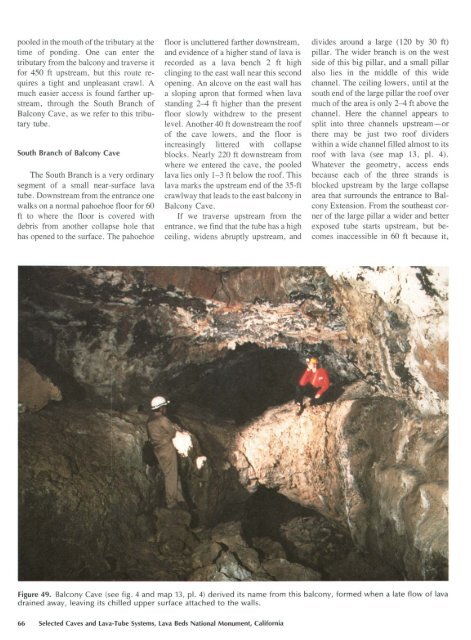Lava cascade in Thunderbolt Distributary of Labyrinth Cave system
report
report
You also want an ePaper? Increase the reach of your titles
YUMPU automatically turns print PDFs into web optimized ePapers that Google loves.
pooled <strong>in</strong> the mouth <strong>of</strong>the tributary at the<br />
time <strong>of</strong> pond<strong>in</strong>g. One can enter the<br />
tributary from the balcony and traverse it<br />
for 450 ft upstream, but this route requires<br />
a tight and unpleasant crawl. A<br />
much easier access is found farther upstream,<br />
through the South Branch <strong>of</strong><br />
Balcony <strong>Cave</strong>, as we refer to this tributary<br />
tube.<br />
South Branch <strong>of</strong> Balcony <strong>Cave</strong><br />
The South Branch is a very ord<strong>in</strong>ary<br />
segment <strong>of</strong> a small near-surface lava<br />
tube. Downstream from the entrance one<br />
walks on a normal pahoehoe floor for 60<br />
ft to where the floor is covered with<br />
debris from another collapse hole that<br />
has opened to the surface. The pahoehoe<br />
floor is uncluttered farther downstream,<br />
and evidence <strong>of</strong> a higher stand <strong>of</strong> lava is<br />
recorded as a lava bench 2 ft high<br />
cl<strong>in</strong>g<strong>in</strong>g to the east wall near this second<br />
open<strong>in</strong>g. An alcove on the east wall has<br />
a slop<strong>in</strong>g apron that formed when lava<br />
stand<strong>in</strong>g 2-4 ft higher than the present<br />
floor slowly withdrew to the present<br />
level. Another 40 ft downstream the ro<strong>of</strong><br />
<strong>of</strong> the cave lowers, and the floor is<br />
<strong>in</strong>creas<strong>in</strong>gly littered with collapse<br />
blocks. Nearly 220 ft downstream from<br />
where we entered the cave, the pooled<br />
lava lies only 1-3 ft below the ro<strong>of</strong>. This<br />
lava marks the upstream end <strong>of</strong> the 35-ft<br />
crawl way that leads to the east balcony <strong>in</strong><br />
Balcony <strong>Cave</strong>.<br />
If we traverse upstream from the<br />
entrance, we f<strong>in</strong>d that the tube has a high<br />
ceil<strong>in</strong>g, widens abruptly upstream, and<br />
divides around a large (120 by 30 ft)<br />
pillar. The wider branch is on the west<br />
side <strong>of</strong> this big pillar, and a small pillar<br />
also lies <strong>in</strong> the middle <strong>of</strong> this wide<br />
channel. The ceil<strong>in</strong>g lowers, until at the<br />
south end <strong>of</strong> the large pillar the ro<strong>of</strong> over<br />
much <strong>of</strong> the area is only 2-4 ft above the<br />
channel. Here the channel appears to<br />
split <strong>in</strong>to three channels upstream-or<br />
there may be just two ro<strong>of</strong> dividers<br />
with<strong>in</strong> a wide channel filled almost to its<br />
ro<strong>of</strong> with lava (see map 13, pl. 4).<br />
Whatever the geometry, access ends<br />
because each <strong>of</strong> the three strands is<br />
blocked upstream by the large collapse<br />
area that surrounds the entrance to Balcony<br />
Extension. From the southeast corner<br />
<strong>of</strong> the large pillar a wider and better<br />
exposed tube starts upstream, but becomes<br />
<strong>in</strong>accessible <strong>in</strong> 60 ft because it,<br />
Figure 49. Balcony <strong>Cave</strong> (see fig. 4 and map 13, pl. 4) derived its name from this balcony, formed when a late flow <strong>of</strong> lava<br />
dra<strong>in</strong>ed away, leav<strong>in</strong>g its chilled upper surface attached to the walls.<br />
66 Selected <strong>Cave</strong>s and <strong>Lava</strong>-Tube Systems, <strong>Lava</strong> Beds National Monument, California















